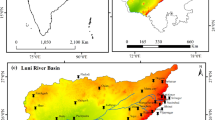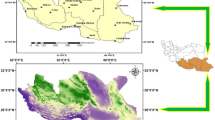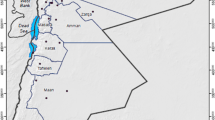Abstract
The Standardized Precipitation Index (SPI) is a powerful tool, requiring only precipitation data for calculating the intensity, duration, magnitude, severity and frequency of drought. Moreover, it provides helpful coverage of drought impacts on multi time scales. In this study, the SPI technique was applied to the dataset of 30 years (1986–2015) to detect drought condition in Northern Pakistan, which is a frequent drought-hit area. The coefficient of variability (CV) was used to analyze precipitation trend, while linear regression model was adopted to detect trend. The detected precipitation variability was spatially interpolated by applying the Inverse Distance Weighted (IDW) technique. It is evident from the analysis that there is great variability in precipitation pattern and trend in the study area. During the winter season, a positive trend in the precipitation variability was detected in the Himalaya and Karakorum region. In the Hindukush region, only Pattan weather station has observed a positive variability trend. In contrast to winter variability, pre-monsoon season has observed an increased variability in the Hindukush region, while the Karakorum and Himalayas regions observed a negative trend. The monsoon season has observed a decreased variation in precipitation throughout the study area except for Pattan. In post-monsoon, Skardu weather station of Himalayas, Gupis and Bunji of Karakorum region and Pattan of Hindukush region have witnessed increased precipitation variability. The meteorological stations of Karakoram and Himalaya have noticed a negative trend of precipitation variability, while in the Hindukush region, all the meteorological stations have witnessed a positive trend of variability except Saidu Sharif and Dir stations. The results of SPI also indicated a drought condition in the study area. Similarly, the SPI results of all return periods have shown a significant drought condition in the Himalayas followed by—in terms of frequency and magnitude—Karakoram and Hindukush, respectively. Based on the above findings, it is recommended that the agriculture experts should work on drought-resilient crops in order to cope up with the harsh prevalent climatic condition in Northern Pakistan.


















Similar content being viewed by others
References
Aba A, Al-Dousari A, Ismaeel A (2018) Atmospheric deposition fluxes of 137Cs associated with dust fallout in the northeastern Arabian Gulf. J Environ Radioact 192:565–572
Abdulrazzaq ZT, Hasan RH, Aziz NA (2019) Integrated TRMM data and standardized precipitation index to monitor the meteorological drought. Civil Engineering Journal 5(7):1590–1598
Abudu S, Sheng Z, Sabzi HZ, King JP (2018) Drought scenario analysis using RiverWare: a case study in Urumqi River Basin, China. Civil Engineering Journal August 4(8)
Adnan S, Ullah K (2020) Development of drought hazard index for vulnerability assessment in Pakistan. Nat Hazards 5–6:1–22
Adnan S, Mahmood R, Khan AH (2009) Water balance conditions in rainfed areas of Potohar and Balochistan plateau during 1931-08. World Appl Sci J 7(2):162–169
Adnan S, Ullah K, Shuanglin L, Gao S, Khan AH, Mahmood R (2018) Comparison of various drought indices to monitor drought status in Pakistan. Clim Dyn 51:1885–1899
Ahmad, S., Hussain, Z., Qureshi, A. S., Majeed, R., & Saleem, M. (2004). Drought mitigation in Pakistan: current status and options for future strategies (Vol. 85): IWMI
Ahmad L, Parvaze S, Majid M, Kanth R (2016) Analysis of historical rainfall data for drought investigation using standard precipitation index (SPI) under temperate conditions of Srinagar Kashmir. Pakistan Journal of Meteorology Vol 13(25)
Ahmed M, Al-Dousari AM (2013) Geomorphological characteristics of the Um-Rimam depression in northern Kuwait. Kuwait Journal of Science 40(1)
Ahmed K, Shahid S, Chung E, Ismail T, Wang X (2017) Spatial distribution of secular trends in annual and seasonal precipitation over Pakistan. Clim Res 74:95–107
Ahmed K, Shahid S, Nawaz N (2018) Impacts of climate variability and change on seasonal drought characteristics of Pakistan. Atmos Res 214:364–374
Ahmed K, Shahid S, Wang X, Nawaz N, Khan N (2019a) Spatiotemporal changes in aridity of Pakistan during 1901–2016. Hydrol Earth Syst Sci 23:3081–3096
Ahmed K, Shahid S, Chung ES, Wang XJ, Harun SB (2019b) Climate change uncertainties in seasonal drought severity-area-frequency curves: case of arid region of Pakistan. J Hydrol 570:473–485
Al-Dousari A, Pye K (2005) Mapping and monitoring of dunes in northwestern Kuwait. Kuwait Journal of Science and Engineering 32(2):119
Al-Dousari AM, Al-Elaj M, Al-Enezi E, Al-Shareeda A (2009) Origin and characteristics of yardangs in the Um Al-Rimam depressions (N Kuwait). Geomorphology 104(3–4):93–104
Al-Dousari AM, Aba A, Al-Awadhi S, Ahmed M, Al-Dousari N (2016) Temporal and spatial assessment of pollen, radionuclides, minerals and trace elements in deposited dust within Kuwait. Arab J Geosci 9(2):95
Al-Dousari A, Al-Nassar W, Al-Hemoud A, Alsaleh A, Ramadan A, Al-Dousari N, Ahmed M (2019) Solar and wind energy: challenges and solutions in desert regions. Energy 176:184–194
Al-Hemoud A, Al-Dousari A, Al-Shatti A, Al-Khayat A, Behbehani W, Malak M (2018) Health impact assessment associated with exposure to PM10 and dust storms in Kuwait. Atmosphere 9(1):6
Al-Sudairawi M, Misak R (1999) Challenges and problems confronting the sustainable development in the desert of Kuwait. Paper presented at the Proceedings of the 9th international conference on environmental protection is a must, Alexandria, Egypt
Baig MHA, Abid M, Khan MR, Jiao W, Amin M, Adnan S (2020) Assessing meteorological and agricultural drought in Chitral Kabul River Basin using multiple drought indices. Remote Sens 12:1–19
Bhatti AS, Wang G, Ullah W, Ullah S, Hagan DFT, Nooni IK, Lou D, Ullah I (2020) Trend in extreme precipitation indices based on long term in situ precipitation records over Pakistan. Water 12:1–19
Burgess CP, Taylor MA, Stephenson T, Mandal A (2015) Frequency analysis, infilling and trends for extreme precipitation for Jamaica (1895-2100). J Hydrol Reg Stud 3:424–443
Cancelliere A, Di Mauro G, Bonaccorso B, Rossi G (2007) Drought forecasting using the standardized precipitation index. Water Resour Manag 21(5):801–819
Cheema SB, Rasul G, Ali G, Kazmi DH (2011) A comparison of minimum temperature trends with model projections. Pakistan Journal of Meteorology 8(15):39–52
Chopra, P. (2006). Drought risk assessment using remote sensing and GIS: a case study of Gujarat
DasGupta R, Shaw R (2015) An indicator based approach to assess coastal communities’ resilience against climate related disasters in Indian Sundarbans. J Coast Conserv 19(1):85–101
Driscoll CT, Driscoll KM, Mitchell MJ, Raynal DJ (2003) Effects of acidic deposition on forest and aquatic ecosystems in New York State. Environ Pollut 123(3):327–336
El-Wahab RA, Al-Rashed A, Al-Dousari A (2018) Influences of physiographic factors, vegetation patterns and human impacts on aeolian landforms in arid environment. Arid Ecosyst 8(2):97–110
Gemmer M, Becker S, Jiang T (2004) Observed monthly precipitation trends in China 1951–2002. Theor Appl Climatol 77(1):39–45
Gu L, Chen J, Xu C-Y, Kim J-S, Chen H, Xia J, Zhang L (2019) The contribution of internal climate variability to climate change impacts on droughts. Sci Total Environ 684:229–246
Han P, Wang PX, Zhang SY, Zhu DH (2010) Drought forecasting based on the remote sensing data using ARIMA models. Math Comput Model 51(11):1398–1403
Higashino M, Stefan HG (2019) Variability and change of precipitation and flood discharge in a Japanese river basin. Journal of Hydrology: Regional Studies 21:68–79
Hussain, M. S., & Lee, S. (2009). A classification of rainfall regions in Pakistan. Journal of the Korean Geographical Society, Vol. 44, No. 5, 2009(605~623)
Keshavarz M, Karami E, Vanclay F (2013) The social experience of drought in rural Iran. Land Use Policy 30(1):120–129
Khan B, Iqbal MJ (2012) Forecasting flood risk in the Indus River system using hydrological parameters and its damage assessment. Arab J Geosci
Khan B, Iqbal MJ, Yousafzai MK (2010) Flood risk assessment of River Indus of Pakistan. Arab J Geosci 4:115–122
Kumar V, Jain SK, Singh Y (2010) Analysis of long-term rainfall trends in India. Hydrological Sciences Journal–Journal des Sciences Hydrologiques 55(4):484–496
Mazhar N, Nawaz M, Mirza A, Khan K (2015) Socio-political impacts of meteorological droughts and their spatial patterns in Pakistan. South Asian Stud 30:135–143
McKee, T., Deosken, N., & Kleist, J. (1993). The relationship of drought frequency and duration to time scales. 8th Conference on Applied Climatology (Vol. 17, No. 22, pp. 179-183)). California
Nabaei S, Sharafati A, Yaseen ZM, Shahid S (2019) Copula based assessment of meteorological drought characteristics: regional investigation of Iran. Agric For Meteorol 276–277:107611
Naheed G, Rasul G (2011) Investigation of rainfall variability for Pakistan. Pakistan Journal of Meteorology 7(14)
Naheed G, Kazmi D, Rasul G (2013) Seasonal variation of rainy days in Pakistan. Pakistan Journal of Meteorology 9(18)
Parvaze S, Majid M, Kanth RH (2016) Analysis of historical rainfall data for drought investigation using standard precipitation index (SPI) under temperate conditions of Srinagar Kashmir. Pakisan Journal of Meteorology 13:29–38
Peters AJ, Walter-Shea EA, Ji L, Vina A, Hayes M, Svoboda MD (2002) Drought monitoring with NDVI-based standardized vegetation index. Photogramm Eng Remote Sens 68(1):71–75
Rahman G, Rahman A, Sami U, Dawood M (2018) Spatial and temporal variation of rainfall and drought in Khyber Pakhtunkhwa Province of Pakistan during 1971–2015. Arab J Geosci 11:1–13
Rashid A (2004) Impact of El-Nino on summer monsoon rainfall of Pakistan. Pakistan Journal of Meteorology 1(2)
Rasul, G., & Chaudhry, Q. (2006). Global warming and expected snowline shift along Northern Mountains of Pakistan. Proc. of 1st Asiaclic Sympos. Yokohama, Japan. a b
Seager R, Tzanova A, Nakamura J (2009) Drought in the southeastern United States: causes, variability over the last millennium, and the potential for future hydroclimate change. J Clim 22(19):5021–5045
Taghavi F (2010) Linkage between climate change and extreme events in Iran. J Earth Sp Phys 36:33–43
Trenberth KE (2011) Changes in precipitation with climate change. Clim Res 47(1–2):123–138
Tsakiris G, Kordalis N, Tigkas D, Tsakiris V, Vangelis H (2016) Analysing drought severity and areal extent by 2D Archimedean copulas. Water Resour Manag 30(15):5723–5735
Ullah S, You Q, Ullah W, Ali A (2018a) Observed changes in precipitation in China-Pakistan economic corridor during 1980–2016. Atmos Res 210:1–14
Ullah S, You Q, Ullah W, Ali A, Xie W, Xie X (2018b) Observed changes in temperature extremes over China-Pakistan economic corridor during 1980-2016. Int J Climatol 39:1457–1475
Ullah S, You Q, Ali A, Ullah W, Jan MA, Zhang Y, Xie W, Xie X (2019a) Observed changes in maximum and minimum temperatures over China-Pakistan economic corridor during 1980-2016. Atmos Res 216:37–51
Ullah W, Wang G, Ali G, Tawia Hagan D, Bhatti A, Lou D (2019b) Comparing multiple precipitation products against in-situ observations over different climate regions of Pakistan. Remote Sens 11:628
Wilhite, D. A. (2000). Drought as a natural hazard: concepts and definitions
Wilhite D (2003) Moving toward drought risk management: the need for a global strategy. University of Nebraska, Lincon, National Drought Mitigation Center
World Meteorological Organization (2012) Standardized precipitation index user guide (M. Svoboda, M. Hayes and D. Wood). (WMO-No. 1090), Geneva
Xie H, Ringler C, Zhu T, Waqas A (2013) Droughts in Pakistan: a spatiotemporal variability analysis using the standardized precipitation index. Water Int 38(5):620–631
Yabi I, Afouda F (2012) Extreme rainfall years in Benin (West Africa). Quat Int 262:39–43
Acknowledgements
We are extremely thankful to the Pakistan Meteorological Department for providing precipitation data for this research study.
Author information
Authors and Affiliations
Corresponding author
Additional information
Responsible Editor: Zhihua Zhang
Rights and permissions
About this article
Cite this article
Khan, I., Waqas, T., Samiullah et al. Precipitation variability and its trend detection for monitoring of drought hazard in northern mountainous region of Pakistan. Arab J Geosci 13, 698 (2020). https://doi.org/10.1007/s12517-020-05700-4
Received:
Accepted:
Published:
DOI: https://doi.org/10.1007/s12517-020-05700-4




